Welcome
to the Pleasure Dome!
The
history and construction of European Salon Carousels
In
the first half of the 20th century Salon Steam Carousels were
the main attraction at many fairs on mainland Europe. They
were more impressive, more spectacular and much bigger than
all other fairground attractions. IDIUS FELIX tells us more
about the operation and history of these magnificent
machines.
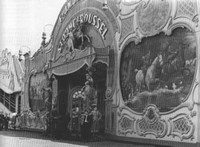 Salon Steam
Carousels dominated almost every mainland European fair in
the first part of the last century. These steam-operated
platform gallopers had their own enclosing tents with huge
facades. They were the place to be at the fair. Not only to
enjoy the ride on one of the horses or gondolas, but also
because the enclosing tent had tables and chairs for
spectators as well as a separate dance floor and a buffet for
refreshments. You can only imagine what parties might have
take place using confetti and serpentines! It has been said
that people always had a great time and a lot of married
couples initially met inside these pleasure domes!
Salon Steam
Carousels dominated almost every mainland European fair in
the first part of the last century. These steam-operated
platform gallopers had their own enclosing tents with huge
facades. They were the place to be at the fair. Not only to
enjoy the ride on one of the horses or gondolas, but also
because the enclosing tent had tables and chairs for
spectators as well as a separate dance floor and a buffet for
refreshments. You can only imagine what parties might have
take place using confetti and serpentines! It has been said
that people always had a great time and a lot of married
couples initially met inside these pleasure domes!
However, from the 1940s onwards travelling the salon steam carousel was barely profitable because of the costs of operation and transport. Visitors to the fair by that time also wanted to go higher and faster. That's why the salon steam carousels were broken up or put into storage. Only a very few examples survive, the best perhaps being at the Efteling Amusement Park in the Netherlands.
Operation
and Transport
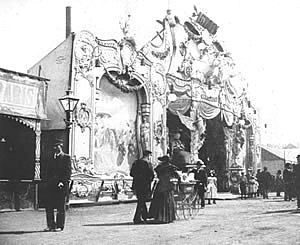 Salon steam
carousels were assemblies from a large number of parts from
several specialist artisans and other (older) fairground
rides. A salon steam carousel was never bought as a whole at
one moment in time. There were no manufacturers that sold
such a ride as a complete item, so the salon steam carousels
mostly evolved into their ultimate appearance by additions
over a number of years. Only a small number of families
actually owned a salon steam carousel. Famous family-names in
the Netherlands were those of Janvier, Wolfs, Benner, Tewe,
Nizet, Sipkema, Gebroeders van Bergen, Vincken and
Schildmeyer, in Belgium you had Demeyer and in Germany there
was the Haase famliy.
Salon steam
carousels were assemblies from a large number of parts from
several specialist artisans and other (older) fairground
rides. A salon steam carousel was never bought as a whole at
one moment in time. There were no manufacturers that sold
such a ride as a complete item, so the salon steam carousels
mostly evolved into their ultimate appearance by additions
over a number of years. Only a small number of families
actually owned a salon steam carousel. Famous family-names in
the Netherlands were those of Janvier, Wolfs, Benner, Tewe,
Nizet, Sipkema, Gebroeders van Bergen, Vincken and
Schildmeyer, in Belgium you had Demeyer and in Germany there
was the Haase famliy.
In their heydays there were about 35 salon carousels travelling the fairs in the Netherlands. Perhaps the most important family in the Netherlands was the Janvier family. Hendrik Janvier (1868-1932) is considered to be the father-figure of all the Dutch salon steam carousel proprietors. It was his carousel that in the 1950s would eventually find its permanent residence in at the Efteling Amusement Park in Kaatsheuvel, where it still operates today. This example is unique in the world because of its completeness.
It still
has its façade with paybox and statues, its enclosing tent,
its steam engine, fair organ in the centre of the carrousel
and its horses and gondolas. In the gallery below you can
make a 'virtual' visit to this unique surviving example.
Travelling a salon steam carousel demanded a lot of personnel
and maintenance. To operate the ride the Janvier family had
more than twenty people on their payroll, including seven
servant-girls and a housekeeper. Building up and pulling down
the carousel as well as opening it at the fair itself was
hard work and was only possible with enough staff. Building
up took about four days and had to be done very carefully.
Each part of the base of the carousel was levelled
individually to make sure that the moving parts could
function properly and the horses and gondolas could be driven
and moved by the mechanisms of toothed wheels, pinions,
eccentrics and rods. As soon as the last visitors left the
carousel was pulled down, systematically packed and put away.
Everything had its own place on the trucks. Pulling down took
about one and a half days. Most of this work was done at
night.
Transport of the salon steam carousel from one fair to
another was done mostly by train. Short distances were
covered on the road. It has been said that sometimes ships
were used as well. The transport of the carousel consisted of
twenty-five trucks, including three living vans, a saloon van
and a kitchen van. Then there were the twelve
"one-axle-trucks" with the horses and gondolas that
made up the revolving platform of the carousel. Loaded on a
train it needed more than twenty-five railway wagons. A total
of more that 150,000 kilogram of materials! Janvier entered
into a special contract with the Dutch National Railways for
transport of the ride. Transport from the railway station to
the fairground and back was done by using horses to pull the
trucks.
Construction
and working of Salon Steam Carousels
(with reference to the Janvier Salon Steam Carousel Efteling
Park)
Revolving
Platform
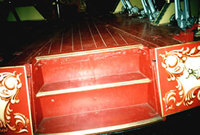 The salon steam
carousel is a platform galloper with rocking horses and
gondolas. The revolving platform of consists of twelve
separate "one-axle-trucks" that are connected and
placed in a circle to form the platform of the ride. In the
carousel of the Sipkema family there were fourteen of these
one-axle-trucks. With the one-axle-trucks in place the
diameter is about 12 metres. The platform-floor of the trucks
is rectangular and it has brass rails. Putting the trucks
together in a circle leaves triangular holes. These
triangular holes are covered with platform panels with steps
to mount the carousel. The space between each set of steps is
filled with painted panels to hide the wheels, gearing,
eccentrics, etc. from view.
The salon steam
carousel is a platform galloper with rocking horses and
gondolas. The revolving platform of consists of twelve
separate "one-axle-trucks" that are connected and
placed in a circle to form the platform of the ride. In the
carousel of the Sipkema family there were fourteen of these
one-axle-trucks. With the one-axle-trucks in place the
diameter is about 12 metres. The platform-floor of the trucks
is rectangular and it has brass rails. Putting the trucks
together in a circle leaves triangular holes. These
triangular holes are covered with platform panels with steps
to mount the carousel. The space between each set of steps is
filled with painted panels to hide the wheels, gearing,
eccentrics, etc. from view.
Horses
and Gondolas
The iron spoked wheels of the one-axle-trucks run in a
U-shaped rail. The movement of the axle of the trucks is
transformed into the galloping movement of the horses and
pigs and the rocking movement of the gondolas and coaches by
toothed wheels, eccentrics, ball-and-socket joints and rods.
In the Janvier carousel there are six trucks with three
abreast horses each, two trucks with two horses and a pig and
four trucks with gondolas and coaches. The twenty-two horses
are by Joseph Hübner, the gondolas and coaches are by Jules
Moulinas. There are two pigs with a clown on their back
thumbing his nose at the riders behind the pig on which he
sits. These pigs with clowns are from the workshops of Carl
Müller. During transport the one-axle-trucks were placed in
line, the mechanism for moving the horses, pigs, gondolas and
coaches was disengaged and the trucks were covered with
canvas. By doing so the horses, pigs, gondolas and coaches
did not need to be removed from the trucks during transport.
Centre
Engine and Organ
In the centre of the steam carousel are the fair organ and
the portable steam centre engine. The fair organ in the
Efteling-carousel is a book organ, built in 1895 by Gavioli.
The steam engine was bought by Hendrik Janvier in 1895. It
was built at the engineering-works of König in Swalmen in
the province of Limburg, The Netherlands, and was built under
license of the famous fairground-engineer Frederick Savage
from King's Lynn in England. During World War Two the boiler
was declared unfit, at a fair in Drunen. As a result an
electric motor was placed on top of the boiler to be able to
drive the carousel. The portable steam engine however is
still in place at Efteling. Nowadays electricity drives the
carousel and the dummy steam engine.
The platform was driven by the steam engine in the following
way: There is a toothed crown wheel under the floor of the
one-axle-trucks on the inside of the circle they form
together. This toothed crown is driven by a toothed wheel
mounted on an axle-rod that reaches from the inside of the
circle formed by the trucks to the centre of the carousel,
under the steam engine. A belt-pulley is mounted on the
axle-rod exactly under the flywheel of the steam engine . The
flywheel and belt-pulley are connected by a belt and the
motion of the steam engine is thus transferred to the
platform of the carousel. In earlier days, the portable steam
engine had a second small steam engine to drive the fair
organ that stood (and still stands) at right angles to the
portable steam engine. At the beginning of the 20th century
the steam engine was also used to generate electricity. This
was absolutely necessary in those days because most of the
cities visited couldn't supply electricity at that time for
the hundreds of lamps inside the carousel. Outside,
carbon-arc lamps were used on the façade.
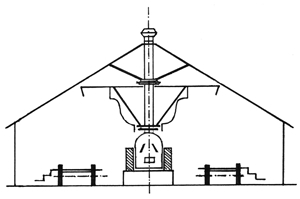 The Chimney
The Chimney
The chimney of the portable steam engine has a threefold
function. Firstly it was used as an outlet for smoke and
steam. Secondly it is the centre of rotation for the spinning
top of the carousel. The diameter of the spinning top is
smaller than the diameter of the revolving platform and it is
connected to the platform by twisted brass rods. Thirdly, as
a centre pole, it supports the enclosing ceiling. Ridge-rods
are fixed to the top of the chimney making an umbrella shape
tent and the ceiling canvas covers these. Red curtains are
suspended on the inside to hide the ridge-rods. In earlier
days, when the weather was good, the canvas and curtains were
partially removed to provide fresh air. A spark-catcher was
mounted onto the chimney when the steam engine was in use.
Gallery
and veranda
There is a gallery and veranda all around the revolving
platform in the salon. The outside of this gallery is formed
by wooden panels, with paintings by Andreas Gerhardus Giezen,
who is responsible for most of the artwork on the inside and
the outside of the steam carousel. Giezen was the son-in-law
of Hendrik Janvier. On the inside of this gallery there are
baroque pillars with ornamentation, mirrors and velvet.
Trellis fencing between the pillars separates riders from
spectators. Tables and chairs are available for the
spectators, as well as a dance floor and a buffet for
refreshments.
Exterior
The exterior sizes of the façade and the tent are
approximately thirty metres wide, nine metres in height and
twenty-two metres deep. The façade of the steam carousel was
originally used as the front of the travelling bioscope show
(Cinematograph) of Eduard Weidauer. Hendrik Janvier bought it
in 1889. It was then repainted by Andreas Giezen, who was
responsible for the three-dimensional paintings. Furthermore
he added statues and enlarged the top of the façade.
When the
steam carousel arrived at Efteling the façade was repainted
by Anton Pieck, a well-known Dutch painter of street-scenes
and the "in-house" painter and designer at the
Efteling Amusement Park. Pieck also added panels to the
Janvier carousel from the Gouke Sipkema steam carousel that
was also obtained by Efteling. The entrance to the interior
is in the centre of the façade. The entrance itself is a
hallway which contains the pay-box. Pieck mounted a female
statue that originally was on Anton Benner's bioscope show on
the top of the façade above the entrance-hallway . Four
small horses originally from the carousel belonging to the
showman Schildmeyer's widow were also placed above the
entrance. The façade is completed by two statues of Egyptian
princesses holding a garland that originally belonged to
Sipkema's carousel.
The
threat of fire
Fire was a big problem for all steam-powered fairground rides
and the salon carousels were no exception. The 6th of October
1946 is in this respect a memorable moment in the history of
the salon steam carousel in The Netherlands. On that date a
salon steam carousel of the Janvier family, called
"Noblesse", burned down during the Liberation Fair
on the Malieveld in The Hague. It is stated that this was the
most beautiful carousel that has ever travelled in The
Netherlands. It had statues and panels in a baroque and
rococo-style that were all hand-carved.
Around midnight the salon carousel was closed for the day. As usual, serpentines and confetti were collected and moved to a spot some distance away from the carrousel tent. After that all the paper was sprayed with water to prevent it to catch fire at a later moment. All personnel was going to sleep, but were awakened in the early morning when a terrible accident had happened and the worst was inevitable: despite the cautions the stoomcarrousel and the cake-walk next to it were on fire!! An eye-witness reported:
" Within the carousel tent the steam engine was heated up because of the fire. The remaining water in the steam engine started boiling as a result of the heat of the fire.The steam engine tried to drive the carrousel, but it was no longer possible to have it make it rounds. Slowly the engine started to puff and puff. The hissing transformed into a howling noise that went to the bone. For several hours the moaning and groaning of the dying engine could be heard. The engine said goodbye in a way that the people present would never forget in their lifes...."
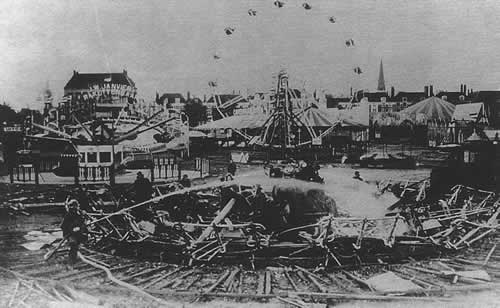 |
 |
| Click here
for the Newspaper Report on the Carousel Fire in the Hague on the 6th of October 1946 |
In
Conclusion
There are two remarkable things about the salon steam
carousel.
| ? |  |
The name of the Janvier Salon Carousel originally was written with one "R" and two "S"-s: "STOOMCAROUSSEL" in Dutch, that would be "STEAM CAROUSSEL" in English, on the carousel itself as well as on the trucks. After its arrival at Efteling, sometime since 1956, this has been changed to "CARROUSELPALEIS" in Dutch, with two "R"-s and one "S", which would be "CARROUSEL PALACE" in English. | ? |
| ? | ? |
| ? | 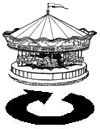 |
Another unusual thing is that the salon steam carousels (mostly) turn clockwise just like gallopers in England. Most of the fairground rides in Europe and The Netherlnds however turn counter-clockwise, as does the Demeyer Salon Carousel at the Ecomusée in Ungersheim, France does. A possible explanation is given by Weedon and Ward: carousels turn clockwise to enable the animals to be mounted from the correct side?! |  |
? |
Click here for our Salon Carousel Picture Gallery
Whenever you visit the Netherlands,
be sure to visit the Janvier Salon Carousel at the
Efteling to get a smell of what it would have been
like at the fairground in the first half of the 20th
century. It's definately worth it! |
|
| News | Forum | Archive | Book Shop | UK Attractions | Euro Attractions | UK Vintage Rides |
